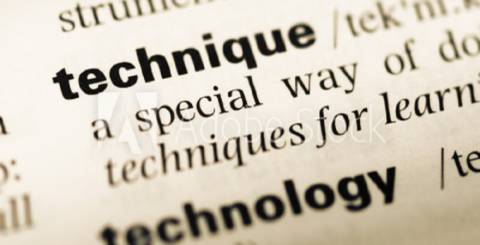Some Translation Techniques You Should Know

The translation process consists of understanding the meaning of a text written in a language of origin and transferring it to a target language while retaining the same meaning.
Before carrying out this translation process correctly, it is convenient to know the different translation techniques available. Depending on the chosen type, the translator must adjust to different parameters to correctly translate the author's original message without ever losing its meaning in the original language.
Most relevant translation techniques
Next, we will review the best-known translation techniques.
The literal translation method
The literal translation or word for word is applicable between two languages when there is a previous correspondence of structure and significance and there is an exact equivalence between the different words. Actually, this type of translation is rarely used.
The semantic loan method
The semantic loan as a translation technique consists of using a word or an expression of the original text exactly the same in the target text. Normally the loans appear in italics in the translations. The idea is to reproduce as it is an expression of the original text in the destination text.
In short, it is a matter of leaving some expression or name that belongs to the cultural heritage of the language of origin untranslated. On many occasions, the terms that designate national institutions that do not have an exact equivalent in the other culture are left in italics in the original language.
The tracing method
The tracing consists in literally translating the elements that make up a Syntagma to avoid falling into foreign words or semantic loans. In short, it is a kind of loan in which the Syntagm of the source language is borrowed, but the elements that compose it are literally translated. An example: «weekend»/«weekend».
The transposition method
This process of transposition consists in changing a grammatical category a part of the sentence without altering its general meaning. Therefore, this technique involves a change in the grammatical structure of the phrase. It is a process that is often applied unconsciously.
The modulation method
Modulation is understood as the translation process that takes place when there is a change in the conceptual basis of a term, in the point of view, in the perspective, but without altering its meaning. It is, therefore, a more abstract plane that consists of adopting a modified point of view or a different metaphorical base.
The equivalence method
When we speak of equivalence when translating, we refer to trying to reproduce the same situation through completely different stylistic and structural resources.
An example of equivalence would be "No parking at all times": "Do not park". Equivalence is very common when translating sayings or sayings proper to a culture. Thus, for example, the British "it's raining cats and dogs" is usually translated by our "it rains cats and dogs".
The adaptation method
This translation technique, also known as the cultural substitution or cultural equivalent, consists of translating cultural elements of the language of origin by others that adapt to the culture of the target language.
The lexical synonymy method
When we speak of lexical synonymy as a translation technique, we refer to when the translator opts for a translation solution in the target language that does not exactly match but approaches the one used in the source language. It is important to remember that we can’t get too far away from the meaning of the original word. Remember that bilingual dictionaries sometimes give words that are not interchangeable in all contexts.
The restructuring method
When a translator uses the restructuring technique he is choosing to change the type of sentence or even the number of sentences to correctly convey the author's message.
Is a translation method the same as a translation technique?
No, it's not the same. In the field of translation, the method and technique are different concepts. Thus, a translation method is applied to the entire text to be translated and the translation techniques may vary within the same text, depending on the case and depending on the verbal elements that have to be translated.
What are the most commonly used translation methods?
In this section, we will talk about a few professional translation services method which could be more useful to understand and make you sense properly.
Interpretive-communicative method: The use of this translation method aims to preserve the same purpose as the original text. It is intended that the translation have the same effect on the reader as the original text.
Literal method: The linguistic system of the source text is reproduced as such, but literally reconverting the linguistic elements that compose it word-for-word translation, Syntagma by phrase or sentence by sentence to the morphology and syntax of the original text.
Free method: The translator moves away from the formal structure of the source text to transmit freely the message of the author of the original text.
Philological method: It is a critical and erudite translation for literary or documentary purposes.
We hope you found this post about translation techniques useful. If you want to know more about the types of translation and interpretation that exist, do not forget to consult the articles of this blog.
Similar Articles
Learn the key differences between formal and informal Persian, including tone, vocabulary, grammar, and their usage in various social contexts.
Does the child in your life speak more than one language? Do you notice them having trouble navigating between the two? How does bilingualism play into speech-language pathology?
Early exposure to English language learning provides you a world of intellectual and social potential. Although it's well known that English is a universal language, you might be surprised by the advantages of learning it at a young age. A child's future can be shaped by early exposure to English in unexpected ways, from confidence-boosting to cognitive development.
As we forge deeper into the digital era, AI language translation is rapidly becoming a pivotal force in global communication, creating unprecedented connections across cultures
Learning to greet someone in a new language is often the first step towards fluency. Understanding how to say hello in Italian is essential due to the language's melodic and expressive nature.
If you are a healthcare provider or employed in the department, you are more likely than not to understand the significance of effective communication particularly in the context of medical information dissemination across various languages and cultures.
Spanish verbs Both the pillar of a language and the main obstacle to speaking it. Many students are lost during their learning, blocked by the Spanish conjugation, sometimes complex for an English speaker. To break the deadlock, these 10 tips are here to finally master the conjugation of this beautiful language, Spanish.
English is an international language and it has become important for everyone to learn and gain mastery over it because it offers plenty of advantages in one’s own personal and professional life.
Matters regarding legal aid translation are sensitive in that they don’t need any barriers caused by language problems, poor translations, or interpretations. The system of providing free advice about the law and practical help with legal matters for individuals who are unable or poor to pay for legal aid services is what we refer to as legal aid.









